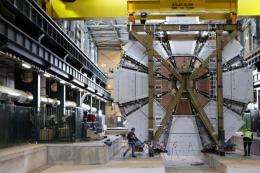Faster than light neutrinos? More like faulty wiring

You can shelf your designs for a warp drive engine (for now) and put the DeLorean back in the garage; it turns out neutrinos may not have broken any cosmic speed limits after all.
Ever since the news came out on September 22 of last year that a team of researchers in Italy had clocked neutrinos traveling faster than the speed of light, the physics world has been resounding with the potential implications of such a discovery — that is, if it were true. The speed of light has been a key component of the standard model of physics for over a century, an Einstein-established limit that particles (even tricky neutrinos) weren’t supposed to be able to break, not even a little.
Now, according to a breaking news article by Edwin Cartlidge on AAAS’ ScienceInsider, the neutrinos may be cleared of any speed violations.
“According to sources familiar with the experiment, the 60 nanoseconds discrepancy appears to come from a bad connection between a fiber optic cable that connects to the GPS receiver used to correct the timing of the neutrinos’ flight and an electronic card in a computer,” Cartlidge reported.
The original OPERA (Oscillation Project with Emulsion-tRacking Apparatus) experiment had a beam of neutrinos fired from CERN in Geneva, Switzerland, aimed at an underground detector array located 730 miles away at the Gran Sasso facility, near L’Aquila, Italy. Researchers were surprised to discover the neutrinos arriving earlier than expected, by a difference of 60 nanoseconds. This would have meant the neutrinos had traveled faster than light speed to get there.
Repeated experiments at the facility revealed the same results. When the news was released, the findings seemed to be solid — from a methodological standpoint, anyway.
Shocked at their own results, the OPERA researchers were more than happy to have colleagues check their results, and welcomed other facilities to attempt the same experiment.
Repeated attempts may no longer be needed.
Once the aforementioned fiber optic cable was readjusted, it was found that the speed of data traveling through it matched the 60 nanosecond discrepancy initially attributed to the neutrinos. This could very well explain the subatomic particles’ apparent speed burst.
Case closed? Well… it is science, after all.
“New data,” Cartlidge added, “will be needed to confirm this hypothesis.”
More information: See the original OPERA team paper here.
Below is an Associated Press article:
European researchers find flaw in experiment that measured faster-than-light particles
By FRANK JORDANS
Researchers have found a flaw in the technical setup of an experiment that startled the science world last year by appearing to show particles travelling faster than light.
The problem may have affected measurements that clocked subatomic neutrino particles breaking what Nobel Prize-winning physicist Albert Einstein considered the ultimate speed barrier.
Two separate issues were identified with the GPS system that was used to time the arrival of neutrinos at an underground lab in Italy, James Gillies, spokesman for the European Organization for Nuclear Research, or CERN, said Wednesday.
One could have caused the speed to be overestimated, the other could have caused it to be underestimated, he said.
"The bottom line is that we will not know until more measurements are done later this year," Gillies told The Associated Press.
The results of the experiment were received with great skepticism by scientists when they were published last September because they seemed to contradict Einstein's theory that nothing can travel faster than the speed of light. That rule is fundamental to modern physics, and breaking it is seen as a step into the realms of science fiction where time travel and warp speed engines exist.
Even researchers involved in the experiment cautioned at the time that the measurements would need to be independently verified by other scientists before a genuine finding could be declared.
The experiment involved neutrinos being fired from CERN's site on the Swiss-French border to a vast underground laboratory 454 miles (730 kilometres) away at Gran Sasso in Italy.
Researchers found that the neutrinos appeared to arrive 60 nanoseconds sooner than if they had been travelling at light's speed of 186,282 miles per second (299,792 kilometres per second).
The experiment's margin of error allowed for just 10 nanoseconds. A nanosecond is one-billionth of a second.
-----
Online: CERN site for neutrino project: bit.ly/nd9sm1
© 2012 The Associated Press. All rights reserved. This material may not be published, broadcast, rewritten or redistributed.
Source: Universe Today





















